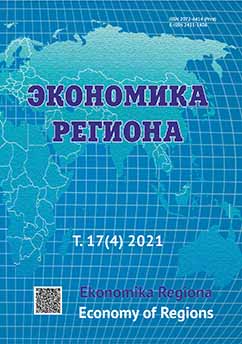Convergence of Russian Regions: Different Patterns for Poor, Middle and Rich
Convergence of Russian Regions: Different Patterns for Poor, Middle and Rich
Author(s): Olga Anatolyevna DemidovaSubject(s): Economy, Geography, Regional studies
Published by: Институт экономики Уральского отделения Российской академии наук
Keywords: Russian regions; convergence; conditional convergence; gross regional product; economic growth; spatial-econometrics models; spatial effects; poor regions; rich regions; economic growth
Summary/Abstract: The Strategy of Spatial Development of the Russian Federation until 2025 aims at the economic growth acceleration and reduction of the intra-regional socio-economic differences. Therefore, the factors affecting the economic growth of regions, convergence of regions, spillover effects from the neighbouring regions are of importance. Russian regions are very different and do not converge to a unique equilibrium path. 80 Russian regions were divided into the groups of poor, middle and rich regions. Three main hypotheses were considered, based on the differences in the 1) convergence speed, 2) influence of the same factors, 3) different mutual influence of regions. They were tested using a modified spatially autoregressive model for the three groups using the Russian regional data for 2000–2017. Beta-convergence was found only for the middle and rich regions, the rate of convergence was higher in the rich regions. The poor regions did not grow faster than the other regions, confirming the relevance of the Strategy of Spatial Development. The similarities and differences were identified in the factors ensuring the economic growth of regions belonging to the three groups. The growth in all regions is stimulated by the regional economy openness. The growth of rich regions can be achieved by increasing the investment and reducing the investment risk. However, the investments in the poor and middle regions are not effective. The poor and middle regions receive positive spillovers from the growth of the neighbouring regions. It is possible to expect reduced differences in the living standards between the poor and rich regions.
Journal: Экономика региона
- Issue Year: 17/2021
- Issue No: 4
- Page Range: 1151-1165
- Page Count: 15
- Language: English

